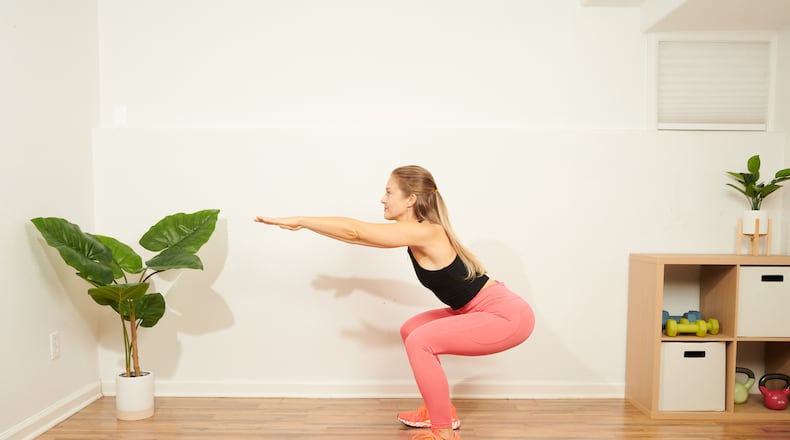Muscles worked: Quadriceps, Hamstrings, Abductors, Glutes and many stabilizing muscles, including those of the low back.
Execution:
Place a resistance band just above the knees with feet a comfortable distance apart, hands on hips or in front of the body as shown. Looking straight ahead, take a larger than normal step to the side, enough to create a stretch of the band. Next, slowly lower the hips by first moving them backward and then bending the knees, until you are in a squat position, and then stand. Continue stepping to the side until you have completed the desired number of repetitions.
If unaccustomed to squatting or if flexibility is an issue practice coming only half way down rather than into a fuller sitting position. Do not descend any further than thighs parallel to the floor. Avoid the knees traveling over the toes and be careful not to round the back. Instead, the spinal column should be kept in alignment all the way to the bottom of the squat and as you return to standing.
Tips:
Safety should always be your first priority when exercising. Check with your doctor before adding new exercises to your workout routine if you have pre-existing injuries or a medical condition. If hip abductors are weak, Side Steps can be performed without using a band.
Adequate balance is required when doing most exercises. If uneasy, proper technique during the squat portion can be practiced by sitting and standing from a chair, or holding onto a sturdy surface as you squat.
Beginners can start with 1 or 2 sets to mild muscle fatigue, every other day or every third day. Starting out conservatively allows you to get a feel for the exercise and avoid doing too much too soon. Some post exercise soreness may be experienced but should subside within 36 to 48 hours.
If unable to maintain the lumber arch when trying to perform this exercise, limit range of motion and work to increase overall flexibility. Include regular stretching for the low back and leg muscles, which can become overly tight over time and interfere with proper range of motion. To stretch the quadriceps (front of thigh) slowly bring the heel toward the rear end while standing. To stretch the hamstrings (back of thigh) slowly bend forward without rounding the back. Hold each stretch 20 seconds or longer.
Variations:
Using a stronger resistance band naturally increases the level of difficulty, as does holding onto a dumbbell or weighted bar. The squat portion can also be held for a few seconds once the hips are lowered and before standing back up and/or reps can be timed at a slower pace. Lastly, the Side Step can be performed without completely standing back up. In this case as each step is taken, the hips are kept in a lowered position.
Marjie Gilliam is an International Sports Sciences Master certified personal trainer and fitness consultant. She owns Custom Fitness Personal Training Services LLC. Send email to marjie@ohtrainer.com.
About the Author

